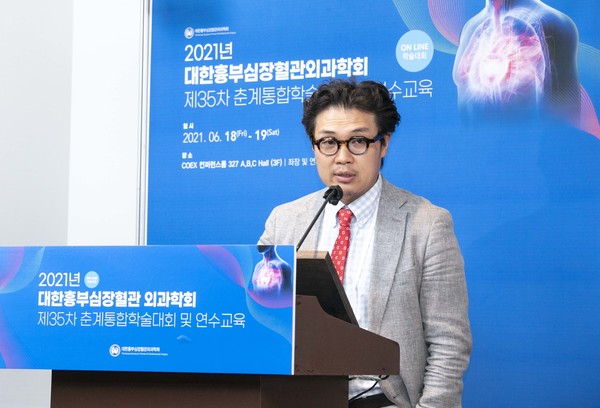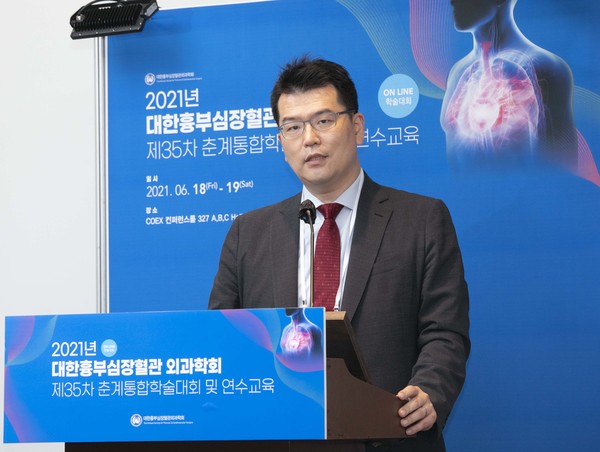Thoracic surgeons call for better standards for improved access to surgical materials
The Korean Society for Thoracic and Cardiovascular Surgery (KTCVS) urged the government to improve access to treatment materials for thoracic surgery and modify standards for providing health insurance coverage on Monday.
"Professionals conducting thoracic and cardiovascular surgeries have been desperately asking for institutional changes even by calling treatment materials essential materials," said Professors Moon Seok-whan at St. Mary's Hospital, who led the discussion at the society’s 35th annual spring conference.
Moon made his demands, as participants discussed the medical device supply system for rare or urgent needs, clinical results of sutureless aortic valve replacement and access to patients, and the directions of health insurance policy for introducing essential therapies for thoracic surgery.
Back in April 2017, the Ministry of Food and Drug Safety revised the regulations on the supply of medical devices to expand patients' access to medical devices used for treating rare and intractable diseases.
The ministry’s move came in response to Gore Co.'s withdrawal of artificial blood vessels for pediatric heart surgery.
"Since the Gore's recall, the government has continued to work to improve regulations on medical devices and tried to resolve the problem by revising the system for supplying rare and urgent medical devices," said Kim Min-jung, a section chief at the ministry said.

The ministry will preemptively and continuously manage the supply of medical devices that bring significant impact on public health by implementing regulations related to reporting suspended manufacturing and importing medical devices from October to prevent precedents, Kim added.
Professor Lee Seung-hyun of the Department of Chest Surgery at Yonsei University College of Medicine pointed out that patients shoulder a heavy burden in receiving sutureless aortic valve replacement surgery.
Lee said that sutureless aortic valve replacement is a procedure that has shown clinically effective outcomes through long-term results from five to 11 years of meta-analysis and patient registry data.
The procedure is regarded as an excellent option. It shortened the operation time, such as time to aortic occlusion and extracorporeal circulation, proved excellence in hemodynamic, and maximized the strengths in concomitant surgery minimally invasive surgery, Lee said.
However, patients have to pay half of the sutureless aortic valve replacement operation, which is about seven million won ($6,170) in Korea.
"The government began to provide health insurance for sutureless aortic valve replacement surgery and covered half of the medical charge from December 2016, but we still need to expand the coverage for better outcomes for patients," Professor Lee said.
Korea still a dump for old medical device models
Professor Jung Jae-seung of the Department of Thoracic and Cardiovascular Surgery at Korea University Anam Hospital asked why domestic health providers have to use old products for surgery due to the belated arrival of equipment essential for operation.

"Those materials for thoracic surgery are directly related to the lives of patients and require the latest technology, but there are many restrictions as the amount used is small, and it is difficult to develop homegrown products," Jung said.
The government has limited the health insurance covering treatment materials to thoracic surgery, such as catheters for extracorporeal circulation, artificial heart valves, valvuloplasty rings, and artificial valves and conduits. The amount covered for these products is about 30 to 60 percent lower than other nations, including the U.S. and Japan.
"Although thoracic and cardiovascular surgeries are considered as essential medical practices, the health insurance covered for those operations have been set low from the beginning, which continued until now and caused difficulties introducing products with the latest technology and left the country as a dump for disposing of old models," Jung said.
The undervaluation of existing products and setting appropriate prices through valuation are blocked by the government's strict requirements for evidence, such as comparative clinical results, leaving domestic patients no choice but to use old products.
Jung added that hospitals sometimes have to use a decades-old femoral cannula for cardiopulmonary surgery, artificial heart valve, and valvuloplasty.
He pointed out that using these devices in thoracic surgeries is smaller than products used for different medical fields. It is practically impossible to provide evidence such as the results of large-scale randomized controlled trials that the government wants for thoracic surgery materials, which would take longer than a decade, Jung said.
Ahn Sang-ho, president of the Korea Congenital Heart Disease Patient Group, figured out a serious problem in the domestic supply of treatment devices after the Gore incident.
"I do appreciate for positive changes in policies modified by the Ministry of Health and Welfare to form separate pricing standards for rare and essential therapeutic materials and the regulatory designation and supply of medical devices," Ahn said. "However, the government should look into current system for problems tagging the same price on products developed 20 to 40 years ago with the recently developed ones and possible improvements in valuation criteria."
Ahn added that providing quality medical devices to the thoracic surgeon can save people's lives, and therapeutic materials are directly linked to saving the lives of adults and children with heart diseases.

